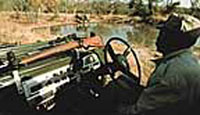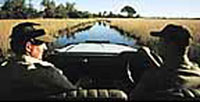The Lighter Side
On Location With Just Two Lenses
Okay, so I lied--but it's a small, white lie. Please let me explain. I do go on location (and on assignment) with just two lenses: my 100-400mm Image Stabilizer zoom and my 17-35mm zoom. My tiny fib is that I use a 1.4x tele-converter (some would call a lens) on my 100-400mm zoom. So, with this system, I have a whopping effective zoom range of 17-560mm. Cool! I took this system on my recent trip to Botswana, and have used it on previous trips to the "dark continent." And it's true! I can shoot my entire assignment with just these two lenses and my trusty tele-converter. I must confess, however, that I pack additional lenses: 20mm, 24mm, 70-200mm, and 300mm. These are my back-up lenses, just in case a rhino runs over my camera bag, or some other less-catastrophic event happens to my gear, like a lens element getting knocked out of alignment while I'm getting knocked around in a safari vehicle. I find that having these two zoom lenses handy--each one mounted on a camera body--helps me get photographs that my fellow travelers miss because they are fumbling around in camera cases looking for lenses. I also find that shooting with two cameras and lots of film and filters stuffed in the pockets of my photo vest gives me the freedom to think/compose/adjust/shoot much faster than a loaded-down shooter. Perhaps the biggest asset of zoom lenses is that you can compose and crop in camera; the wider the zoom range, the more freedom you have when it comes to composition. (Professional photographer George Lepp often shoots with a 35-350mm zoom for this very reason.) When I look through the camera's viewfinder, I zoom in and out several times before I shoot, placing the subject in different areas of the frame. Taking the time to do this (when I have the time, that is) lets me see the difference between say a portrait of an animal (tele-zoom) and a picture of the animal in its environment (wide angle zoom). What's more, zooming is fun. Plus, it makes one feel creative! |
|||
I like zoom lenses for another reason: I enjoy the challenge, and therefore the reward, of shooting with a limited system. Think about it. The early LIFE magazine photographers shot many stories and covers with just one lens--and the pictures were terrific! So, challenge, and reward, yourself. Now, some of you long-time and dedicated shooters may be saying, "How can Sammon shoot with zooms? Don't they produce soft pictures? And how about that tele-converter? I thought these add-on lenses produced very soft pictures?" |
|||
Well, my friends, those were the zoom lenses of yesteryear--lenses that pros, including yours truly, did not use. Today's zooms produce super-sharp pictures. In fact, I had one picture taken with a Canon 17-35mm zoom and Kodachrome 64 that was enlarged to 30x60' for display on the Kodak Colorama in New York's Times Square. Looked sharp to me--even with binoculars! And as far as my 1.4x tele-converter goes, even in 11x14" prints I can't see any softness. But that sharpness comes at a price: 1.4x tele-converters are often more expensive than same-brand 2x converters, which tend to be softer than less powerful tele-converters. But wait! My dad (a photographer) says that if you notice the softness in the picture (as well as the grain), the picture is probably a bore anyway. To this, I ask the following question: "What's worse, a slightly soft picture or no picture at all?" Back to being honest. I guess it's time to bring up another accessory I use (back home): Adobe Photoshop. This computer imaging program lets me sharpen my scanned 35mm pictures--up to 500 percent (although I rarely sharpen a picture more than 40 percent). So, even if a tele-converter is not that sharp, all is not lost, thanks to digital enhancements. |
|||
Perhaps I'll write a Shutterbug article sometime in the future entitled, "On Location with Just Two Lenses and a Computer." You see, when I save up enough for three pro-quality digital cameras (two for shooting and one as a back-up), I'll probably be downloading photo files on site, enhancing them (as I do--to be honest), and sending them off to Shutterbug--if I can find a phone line while on safari in places like Botswana€or if my computer, like Global Star phones, work via satellite. |




































